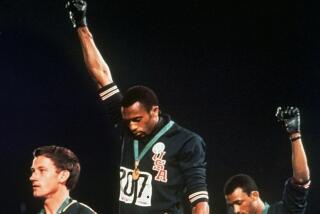Keino Reflects on Legendary Race
- Share via
MEXICO CITY — This is where the legend of Kip Keino began, in 1968 at Olympic Stadium, and for the first time in 34 years the legend himself made a pilgrimage Wednesday to the stadium where he first won Olympic gold.
If anyone is entitled to boast about what he did in the Olympic Games so long ago, it is Keino. Winner of one of the most celebrated 1,500-meter races ever at the 1968 Mexico City Games. Winner of three other Olympic medals -- another one in 1968 and two in 1972.
But that has never been the Keino way. Upon seeing the track, Keino, now 63 and the International Olympic Committee member in his native Kenya, bounded out of a tour bus, trotted down the ramp into the stadium -- wearing a green print shirt, long dark pants and shoes not made for running -- and spontaneously ran a lap. “It’s an honor for me,” he said, still humble. “A great honor for me to be here after 34 years.”
In opening the IOC’s 114th session Wednesday evening, Jacques Rogge, the current president, provided a sobering reminder of the times in which we live and the challenges confronting international sport.
Security is “the No. 1 priority” for any sports organization, he told an audience that included Mexican President Vicente Fox and numerous other dignitaries. Terrorism seeks “to bring peoples, cultures and religions into conflict.” The world, Rogge made it plain, hungers for what sport can give: “The values that inspire us.”
In short, more memories like those of Keino in 1968.
Heading into those Games, most attention was focused on American Jim Ryun. Ryun -- now a U.S. congressman from Kansas -- hadn’t lost at the 1,500 or the mile in more than three years. Yet Ryun had been slowed before the Games by mononucleosis earlier in the summer.
Keino was known by only a few track and field experts. But he had an advantage that now is well appreciated but at the time was little understood -- he had been training long distances in the thin air at high altitude in Kenya. Mexico City sits at more than 7,000 feet.
Keino, however, had his own difficulties -- a gall-bladder infection. In his first race, the 10,000 meters, he doubled over in pain, fell onto the infield and when the stretcher-bearers came to get him, got up and, though he was by then disqualified, finished his final two laps.
Four days later, he won silver in the 5,000 meters.
The day of the 1,500, he was stuck in a traffic jam and jogged the last mile to the stadium.
On the second lap, Keino poured it on, passing the 800-meter mark in, as Olympic historian David Wallechinsky puts it, a “seemingly suicidal” 1:55.3. Everyone waited for Keino to wilt. He didn’t. Instead, he won by 20 meters in a then-Olympic record 3:34.9, Ryun taking silver.
After the race, as he was taking his victory lap, he neared the long-jump pit. There, awestruck at what he had done, was American Bob Beamon, who had just leaped 29 feet 2 1/2 inches -- one of the most memorable Olympic performances ever, a record that would last for 23 years. “He couldn’t say a word,” Keino recalled.
That same day in Kenya, Keino’s wife, Phyllis, gave birth to their third daughter. The Keinos have since adopted scores of children; they run an orphanage and a school in Eldoret, Kenya.
In honor of Beamon, Keino took a joyful leap Wednesday off the long-jump path, into the pit. So did Charmaine Crooks, a Canadian IOC member who, running in the relays in the 1984 Los Angeles Games, won silver.
Then it was time to go -- to get dressed up in evening clothes to listen to Rogge, to think about what lies ahead while remembering what has come before, and to be mindful of another lesson about Olympic greatness. “He’s always been so humble,” Crooks said of Keino. “That humility -- it’s something every athlete could learn from.”
More to Read
Go beyond the scoreboard
Get the latest on L.A.'s teams in the daily Sports Report newsletter.
You may occasionally receive promotional content from the Los Angeles Times.






